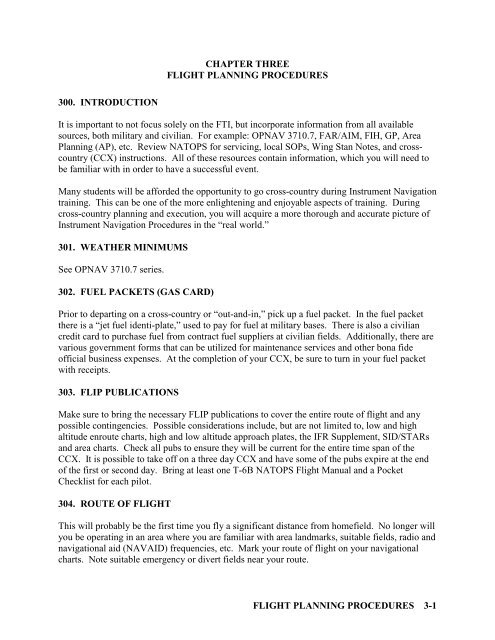Flight Training Instruction - Cnatra - U.S. Navy
Flight Training Instruction - Cnatra - U.S. Navy
Flight Training Instruction - Cnatra - U.S. Navy
You also want an ePaper? Increase the reach of your titles
YUMPU automatically turns print PDFs into web optimized ePapers that Google loves.
300. INTRODUCTION<br />
CHAPTER THREE<br />
FLIGHT PLANNING PROCEDURES<br />
It is important to not focus solely on the FTI, but incorporate information from all available<br />
sources, both military and civilian. For example: OPNAV 3710.7, FAR/AIM, FIH, GP, Area<br />
Planning (AP), etc. Review NATOPS for servicing, local SOPs, Wing Stan Notes, and crosscountry<br />
(CCX) instructions. All of these resources contain information, which you will need to<br />
be familiar with in order to have a successful event.<br />
Many students will be afforded the opportunity to go cross-country during Instrument Navigation<br />
training. This can be one of the more enlightening and enjoyable aspects of training. During<br />
cross-country planning and execution, you will acquire a more thorough and accurate picture of<br />
Instrument Navigation Procedures in the “real world.”<br />
301. WEATHER MINIMUMS<br />
See OPNAV 3710.7 series.<br />
302. FUEL PACKETS (GAS CARD)<br />
Prior to departing on a cross-country or “out-and-in,” pick up a fuel packet. In the fuel packet<br />
there is a “jet fuel identi-plate,” used to pay for fuel at military bases. There is also a civilian<br />
credit card to purchase fuel from contract fuel suppliers at civilian fields. Additionally, there are<br />
various government forms that can be utilized for maintenance services and other bona fide<br />
official business expenses. At the completion of your CCX, be sure to turn in your fuel packet<br />
with receipts.<br />
303. FLIP PUBLICATIONS<br />
Make sure to bring the necessary FLIP publications to cover the entire route of flight and any<br />
possible contingencies. Possible considerations include, but are not limited to, low and high<br />
altitude enroute charts, high and low altitude approach plates, the IFR Supplement, SID/STARs<br />
and area charts. Check all pubs to ensure they will be current for the entire time span of the<br />
CCX. It is possible to take off on a three day CCX and have some of the pubs expire at the end<br />
of the first or second day. Bring at least one T-6B NATOPS <strong>Flight</strong> Manual and a Pocket<br />
Checklist for each pilot.<br />
304. ROUTE OF FLIGHT<br />
This will probably be the first time you fly a significant distance from homefield. No longer will<br />
you be operating in an area where you are familiar with area landmarks, suitable fields, radio and<br />
navigational aid (NAVAID) frequencies, etc. Mark your route of flight on your navigational<br />
charts. Note suitable emergency or divert fields near your route.<br />
FLIGHT PLANNING PROCEDURES 3-1
















